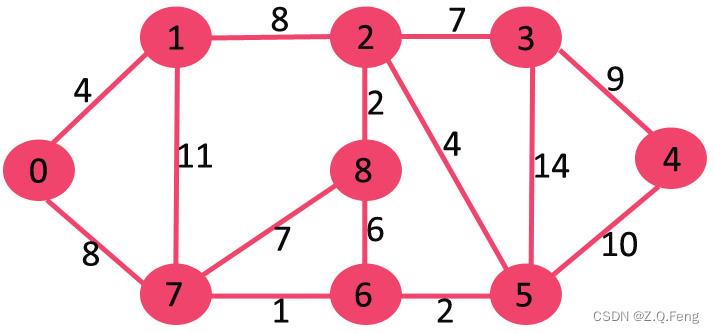Dijkstra C++ 邻接矩阵
Posted
tags:
篇首语:本文由小常识网(cha138.com)小编为大家整理,主要介绍了Dijkstra C++ 邻接矩阵相关的知识,希望对你有一定的参考价值。
求可以调试通过的正确代码!!!谢谢!!!!
自己写的,你可你把里面的主体提出来单做一个函数,测试通过。#include <stdio.h>
#include <string.h>
#define MAX 20
int mincost(int V[], int D[], int n);
int main()
int C[MAX][MAX]; //邻接矩阵
int D[MAX], V[MAX] = 0 ; /*数组V用来表示每次计算加入集合V的点,1为加入了,0为还没有加入*/
int n, i, j, k, w, sum;
printf("请输入顶点个数:");
scanf("%d", &n);
printf("\n请输入建立后的临接矩阵(用n*n矩阵表示), 输入100000表示无穷大:\n");
for(i = 1; i <= n; i++)
for(j = 1; j <= n; j++)
scanf("%d", &C[i][j]);
//以下部分可以提出作为一个函数,计算最短路
V[1] = 1; /*1为源点*/
for(i = 1; i <= n; i++)
D[i] = C[1][i]; /*D置初值*/
for(i = 1; i <= n; i++)
/*从集合S(即没有经过计算的点)中选出一个点w(即V中值为0),使D[w]值最小*/
w = mincost(V, D, n);
V[w] = 1;
/*由于w的选定,S中的每个点(即V中值为0的点都要重新计算其到源点的最小值*/
for(k = 2; k <= n; k++)
if(V[k] == 0)
sum = D[w] + C[w][k];
if(sum < D[k])
D[k] = sum;
for(i = 2; i <= n; i++)
printf("D[%d] = %d\n", i, D[i]);
memset(V, 0, MAX * sizeof(int)); /*初始化*/
return 0;
int mincost(int V[], int D[], int n)
int temp = 10000000, i, w = 2;
for(i = 2;i <= n; i++)
if(V[i] == 0 && D[i] < temp)
temp = D[i];
w = i;
return w;
参考技术A 网上一找就能找到
基于邻接矩阵的Dijkstra算法——C++实现
一、前言
本文实现的Dijkstra(迪杰斯特拉)算法包含如下功能:
- 可指定起始点和初始点
- 能够计算起始点和初始点之间的最短路径长度
- 能够输出起始点和初始点之间的最短路径(中间节点)
本文中我们使用到的图如下:

运行效果如下(代码中节点从 1 开始,其对应上图中路径为0-1-2-8):

二、数据准备
将上图中一共有9个顶点、14条边,对应的是一个9x9的邻接矩阵,储存这些数据到edges.txt文件中:
9 14
0 4 0 0 0 0 0 8 0
4 0 8 0 0 0 0 11 0
0 8 0 7 0 4 0 0 2
0 0 7 0 9 14 0 0 0
0 0 0 9 0 10 0 0 0
0 0 4 0 10 0 2 0 0
0 0 0 14 0 2 0 1 6
8 11 0 0 0 0 1 0 7
0 0 2 0 0 0 6 7 0
邻接矩阵中的值为对应路径之间的权值(可为浮点数,但是必须以空格分隔),不相连的点之间我们记权值为 0。
三、头文件及数据结构
定义结构体MGraph储存图的所有信息:
#include<climits>
#include<iostream>
#include <fstream>
using namespace std;
#define MaxSize 100
typedef double MAT[MaxSize][MaxSize];
//图的邻接矩阵存储结构
typedef struct
//邻接矩阵
MAT edges;
//图中当前的顶点数和边数
int vexnum, arcnum;
MGraph;
四、Dijkstra算法
代码如下:
// Function to print shortest path from source to j
// using parent array(not include the begin node)
void printPath(int parent[], int j)
// Base Case : If j is source
if (parent[j] == -1)
return;
printPath(parent, parent[j]);
cout << j << " ";
// this method returns a minimum distance for the
// vertex which is not included in Tset.
int minimumDist(double dist[], bool Tset[], int count)
int i, min = INT_MAX, index;
for(i = 1; i <= count; i++)
if(Tset[i]==false && dist[i]<=min)
min = dist[i];
index = i;
return index;
double Dijkstra(MGraph *G, int src, int end, int flag)
/*
Reference :
https://www.educative.io/edpresso/how-to-implement-dijkstras-algorithm-in-cpp
modified by z.q.feng at 2022.05.29
*/
int i, j, m;
// integer array to calculate minimum distance for each node.
double dist[MaxSize];
// boolean array to mark visted/unvisted for each node.
bool Tset[MaxSize];
// Parent array to store shortest path tree
int parent[MaxSize];
// set the nodes with infinity distance except for the
// initial node and mark them unvisited.
for(i = 1; i <= G->vexnum; i++)
dist[i] = INT_MAX;
Tset[i] = false;
parent[i] = -1;
// Source vertex distance is set to zero.
dist[src] = 0;
for(i = 1; i <= G->vexnum; i++)
// vertex not yet included.
m = minimumDist(dist, Tset, G->vexnum);
// m with minimum distance included in Tset.
Tset[m] = true;
for(j = 1; j <= G->vexnum; j++)
// Updating the minimum distance for the particular node.
if(!Tset[j] && G->edges[m][j] && dist[m] != INT_MAX
&& dist[m] + G->edges[m][j] < dist[j])
parent[j] = m;
dist[j] = dist[m] + G->edges[m][j];
// 设置flag值为1以输出该条最短路径
if (flag)
cout << src << " ";
printPath(parent, end);
cout << endl;
return dist[end];
五、运行示例
编写主函数如下,读取edges.txt文件中的数据并查看节点 1 和 9 之间的最短路径及其长度:
int main(int argc, char const *argv[])
int i, j;
MGraph G;
// 从文件中读取数据
ifstream fin;
fin.open("edges.txt");
// 顶点数 边数
fin >> G.vexnum >> G.arcnum;
// 读取带权邻接矩阵(空格分割)
for (i = 1; i <= G.vexnum; i++)
for (j = 1; j <= G.vexnum; j++)
fin >> G.edges[i][j];
fin.close();
int src = 1, end = 5, m;
cout<<"\\n\\tThe shortest path from "<<src<<" to "<<end<<" is\\n\\n\\t\\t";
// 设置flag值为1以打印该条路径
m = Dijkstra(&G, src, end, 1);
cout<<"\\n\\tThe shortest distance is "<<m<<endl;
return 0;
输出如下所示,注:代码中的节点均从 1 开始,若图中初始节点为 0,需要做对应修改:

代码中节点从 1 开始,其对应上图中路径为0-7-6-5-4。
六、总结
无
以上是关于Dijkstra C++ 邻接矩阵的主要内容,如果未能解决你的问题,请参考以下文章